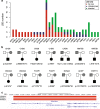Inherited and multiple de novo mutations in autism/developmental delay risk genes suggest a multifactorial model
- PMID: 30564305
- PMCID: PMC6293633
- DOI: 10.1186/s13229-018-0247-z
Inherited and multiple de novo mutations in autism/developmental delay risk genes suggest a multifactorial model
Abstract
Background: We previously performed targeted sequencing of autism risk genes in probands from the Autism Clinical and Genetic Resources in China (ACGC) (phase I). Here, we expand this analysis to a larger cohort of patients (ACGC phase II) to better understand the prevalence, inheritance, and genotype-phenotype correlations of likely gene-disrupting (LGD) mutations for autism candidate genes originally identified in cohorts of European descent.
Methods: We sequenced 187 autism candidate genes in an additional 784 probands and 85 genes in 599 probands using single-molecule molecular inversion probes. We tested the inheritance of potentially pathogenic mutations, performed a meta-analysis of phase I and phase II data and combined our results with existing exome sequence data to investigate the phenotypes of carrier parents and patients with multiple hits in different autism risk genes.
Results: We validated recurrent, LGD, de novo mutations (DNMs) in 13 genes. We identified a potential novel risk gene (ZNF292), one novel gene with recurrent LGD DNMs (RALGAPB), as well as genes associated with macrocephaly (GIGYF2 and WDFY3). We identified the transmission of private LGD mutations in genes predominantly associated with DNMs and showed that parental carriers tended to share milder autism-related phenotypes. Patients that carried DNMs in two or more candidate genes show more severe phenotypes.
Conclusions: We identify new risk genes and transmission of deleterious mutations in genes primarily associated with DNMs. The fact that parental carriers show milder phenotypes and patients with multiple hits are more severe supports a multifactorial model of risk.
Keywords: Autism spectrum disorders; De novo mutations; Genotype–phenotype relationship; Multifactorial model; Multiple hit; Targeted sequencing.
Conflict of interest statement
All study procedures were in accordance with the ethical standards of the Institutional Review Board of the School of Life Sciences at Central South University (CSU), Changsha, Hunan, China. Informed consent was obtained from the parents or legal guardians of all study participants.Written informed consent for publication was obtained from the parents or legal guardians.EEE is on the scientific advisory board (SAB) of DNAnexus, Inc.Springer Nature remains neutral with regard to jurisdictional claims in published maps and institutional affiliations.
Figures



References
-
- Kanner L. Autistic disturbances of affective contact. Nervous Child. 1943;2:217–250. - PubMed
-
- Christensen DL, Baio J, Van Naarden Braun K, Bilder D, Charles J, Constantino JN, et al. Prevalence and characteristics of autism spectrum disorder among children aged 8 years--Autism and Developmental Disabilities Monitoring Network, 11 Sites, United States, 2012. Morb Mortal Wkly Rep Surveill Summ. 2016;65:1–23. - PMC - PubMed
Publication types
MeSH terms
Grants and funding
LinkOut - more resources
Full Text Sources
Medical
Miscellaneous

